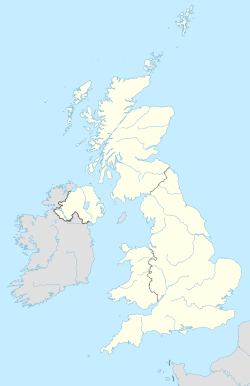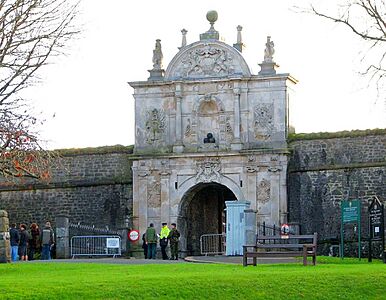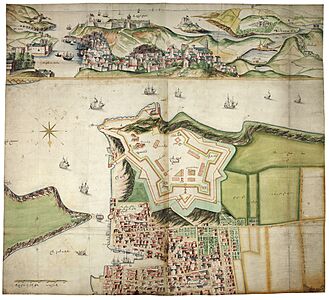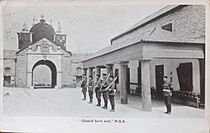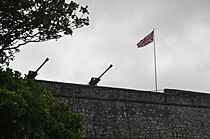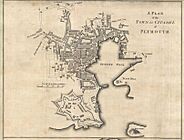Royal Citadel, Plymouth facts for kids
Quick facts for kids Royal Citadel |
|
|---|---|
| Citadel | |
| Plymouth, Devon in England | |
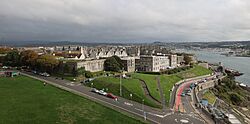
The western view of the Citadel from the balcony of Smeaton's Tower
|
|

Badge of the Royal Regiment of Artillery
|
|
|
Location in Devon
|
|
| Coordinates | 50°21′53″N 4°08′15″W / 50.36472°N 4.13750°W |
| Type | Fortress, Military base |
| Site information | |
| Owner | Crown Estate |
| Operator | |
| Controlled by | 29 Commando Regiment Royal Artillery |
| Open to the public |
Yes |
| Site history | |
| Built | 1592–1598 1665–1675 (Second fortification) |
| In use | 1598–present |
| Materials | Limestone and granite |
| Events | Dutch Wars World War II |
| Garrison information | |
| Current commander |
Lt Col Mark Dornan |
| Garrison | 29 Commando Regiment Royal Artillery |
| Occupants |
|
The Royal Citadel is a historic fortress in Plymouth, Devon, England. It was built in the late 1660s. The design was created by Sir Bernard de Gomme. You can find it at the eastern end of Plymouth Hoe. It looks out over Plymouth Sound.
The Citadel includes the site of an older fort. This fort was built during the time of Sir Francis Drake. Today, the Citadel site is a protected monument. Many of its buildings are also listed as important historical structures.
Contents
History of the Royal Citadel
The First Fort: Drake's Fort
In 1590, Sir Francis Drake was asked to make Plymouth's defenses better. He first set up some temporary gun positions. Then, Drake asked the Privy Council for money. He wanted to build a strong fort on Plymouth Hoe. This fort would protect the Cattewater. The Cattewater was the main way to get to Sutton Harbour. Sutton Harbour was Plymouth's main port back then.
By May 1592, Elizabeth I agreed to fund the fort. Money would come from a tax on exported pilchards. Building the fort took a long time, until 1596. The government even had to bring in 500 more workers to finish it. The northern side of the fort, facing land, had two strong bastions. It also included older gun positions. These overlooked the Cattewater. The Fisher's Nose Blockhouse, built around 1540, was also part of it. Another blockhouse, Queen Elizabeth's Tower, was built nearby.
Building the Royal Citadel
During the Dutch Wars (1664-1667), King Charles II saw how important Plymouth was. It was a key port on the English Channel. The first idea was to build a new, regular fort. It would have five bastions, west of Drake's Fort. But this plan changed. The new Citadel was built to include the older fort. This is why it has an unusual shape.
Some people think the Citadel's guns could also fire on the town. This might have been because Plymouth supported the Parliamentarians. They were against the King in the English Civil War. Sir Bernard de Gomme's design faced some criticism. For example, Samuel Pepys visited in 1683. He wrote that "De Gomme hath built very sillily."
Work on the Citadel started in March 1665. The foundation stone was laid on July 18, 1666. John Granville, 1st Earl of Bath laid this stone. You can still see it in the wall facing the Hoe. It says 'Jo Earle of Bathe 1666'. Parts of the older Tudor fort were used in the new building. The Citadel is made from local limestone. Its main gateway is in the English Baroque style. It was designed by Sir Thomas Fitz and made of Portland stone.
The gateway used to have a drawbridge over a dry moat. But these, and other outer defenses, were removed in the 1880s. Across from Fisher's Nose is the Queen Anne's Battery. This part dates from 1667.
The Citadel's Later Use
The Royal Citadel was a very important defense for England for over 100 years. Its walls were 70 feet high. It was made stronger many times, especially in the 1750s. Back then, it had 113 guns. In 1860, a special commission suggested building new forts. These "Palmerston Forts" would defend Plymouth from further away. But the Citadel was still seen as a valuable support.
In the later Victorian period, the Citadel was used for training. The Royal Garrison Artillery taught soldiers there. During World War II, the Citadel was a headquarters. It was for the Coast Artillery Training Centre. After the war, the Coast Artillery School moved there. It joined with the last regular coast artillery regiment. They trained new soldiers until the Coast Artillery was ended in 1956.
Today, the Royal Citadel is still used by the military. It is the base for the 29th Commando Regiment Royal Artillery. This special unit of the British Army helps the 3 Commando Brigade of the Royal Marines. Sometimes, you can take guided tours of the Citadel.
Right next to the Citadel, a Royal Navy supply yard was built. This yard provided food and supplies for ships. It closed in the 1830s. Since then, this area has been part of the military base. It can hold vehicles too big for the old gateway.
Units Based at the Royal Citadel
The Royal Citadel is home to important military units.
British Army Units
Royal Artillery
- 3 Commando Brigade
- 29th Commando Regiment
The Future of the Citadel
In November 2016, a plan called A Better Defence Estate was released. It said that the Ministry of Defence would no longer own the Royal Citadel by 2024. This date was later changed to 2035.
Garrison Church
The Royal Chapel of St Katherine-upon-the-Hoe was first allowed to hold services in 1371. Between 1666 and 1671, the old church was taken down. The current main part, chancel, and sanctuary were rebuilt in the same spot. Galleries and transepts were added in 1845. These additions made the building look like a cross. King George V gave the church the title Royal Chapel again in 1927. This happened during his visit to the Royal Citadel.
The Royal Citadel in Media
The 2011 BBC TV show The Choir: Military Wives featured the Royal Citadel. It also showed RMB Chivenor in Devon. The show followed choirmaster Gareth Malone. He formed a choir of wives and partners of Royal Citadel personnel. Their partners were serving in the Afghanistan War. Malone wanted to boost the women's spirits. He also wanted to raise public awareness of their lives.
The Military Wives Choir recorded the song "Wherever You Are". It became the Christmas number one in 2011. Money from the song went to charities. These included the Royal British Legion and SSAFA Forces Help.
Visiting the Royal Citadel
You can visit the Royal Citadel only by taking a guided tour.
Gallery
-
105 mm Light Guns of 29th Commando Regiment Royal Artillery on the rampart at the Citadel.
-
"A Plan of the Town and Citadel of Plymouth" by Benjamin Donn in 1765. It shows the Citadel's design, including outer defenses now gone.



